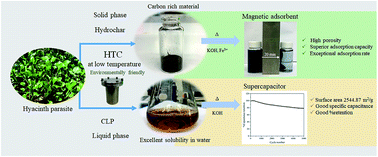Green and sustainable zero-waste conversion of water hyacinth (Eichhornia crassipes) into superior magnetic carbon composite adsorbents and supercapacitor electrodes†
Abstract
Troublesome aquatic weed, water hyacinth (Eichhornia crassipes) was converted into solid and liquid fractions via green and energy-saving hydrothermal carbonization (HTC). The solid product, hydrochar, was employed as a precursor to prepare magnetic carbon materials by simple activation and magnetization using KOH and Fe3+ ions, respectively. The obtained magnetic adsorbent possessed good magnetic properties and presented outstanding capacities to adsorb methylene blue (524.20 mg g−1), methyl orange (425.15 mg g−1) and tetracycline (294.24 mg g−1) with rapid adsorption kinetics even at high concentrations (up to 500 mg L−1), attributed to high specific surface area and mesopore porosity. Besides the solid hydrochar, the water-soluble liquid product was used to fabricate carbon-based supercapacitors through facile KOH activation with a considerably lower KOH amount in comparison to conventional activation. The supercapacitor electrode made from activated liquid product possessed an extremely high specific surface area of 2545 cm2 g−1 and showed excellent specific capacitance (100 F g−1 or 50 F cm−3 at 1 A g−1) and good retention of capacitance (92% even after 10 000 cycles). This work demonstrated that both solid and liquid HTC fractions from this bio-waste can serve as effective sources to prepare functional carbon materials, making this approach a sustainable zero-waste biomass conversion process.

- This article is part of the themed collection: Editors' collection: Physical Chemistry of Colloids and Interfaces


 Please wait while we load your content...
Please wait while we load your content...